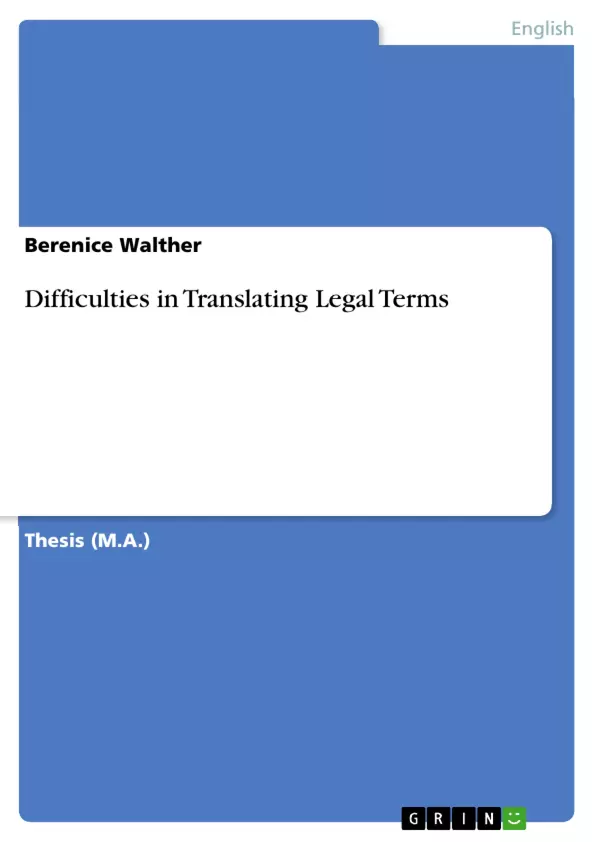In this paper, the major aspects of and essential developments in translation theory, including the ever-recurring question of what constitutes a good translation, will be explored and the particularity of legal translation will be discussed. In the translation of national law terms, many facets have to be kept in mind. For example, the mastering of the different languages poses problems as does the relation of legal texts to different and specific legal systems and cultures. The focus will then switch to legal language in particular. The opposition between word meaning of everyday language and the word meaning of languages for specific purposes will be clarified. Then, particular difficulties in legal language and translation with consideration of the different legal systems where these translations are used will be illustrated with respect to the nature of legal discourse, its dependence on the legal system and the presentation of possible ambiguities and their interpretation. The problem of a common legislation in the European Union is one of finding a legal terminology that is not influenced by its cultural environment – an entirely impossible enterprise.
Inhaltsverzeichnis (Table of Contents)
- 1. Introduction
- 2. State of the Art
- 2.1 Translation Studies and Languages for Specific Purposes (LSP)
- 2.2 What is a (good) translation?
- 2.2.1 The translation
- 2.2.2 The "free" versus "literal" translation debate
- 2.2.3 Equivalence of meaning in translation
- 2.2.4 Official quality standards
- 2.3 Legal language
- 2.3.1 Languages for Specific Purposes (LSP)
- 2.3.2 Word meaning of LSP versus everyday language
- 2.3.3 Legal language use
- 2.3.4 Particular difficulties in translating legal terms
- 3. Theoretical Foundation
- 3.1 The Dialogic Action Game
- 3.1.1 The Action Principle, the Dialogic Principle and the Coherence Principle
- 3.1.2 Rules versus conventions
- 3.1.3 The speech act
- 3.1.4 The quasi-universal structure and predicating fields
- 3.1.5 The expression side
- 3.2 Legal action games
- 3.2.1 Functions the model must fulfill
- 3.2.2 Legal thinking as a part of the action game
- 3.2.3 Representative, directive and explorative action games
- 3.3 Possible solutions in legal translation
- 3.4 Discussion of the methodological approach
- 3.4.1 The aim of the analysis
- 3.4.2 Corpora in the comparative analyses
- 3.4.3 Implementation of the comparative analysis
- 4. Comparative Analysis of translations of English, German and French Legal Terms
- 4.1 Conscientious objection
- 4.2 Property
- 4.3 Protection of personal data
- 4.4 Right to asylum
- 5. Summary and Outlook
Zielsetzung und Themenschwerpunkte (Objectives and Key Themes)
This paper aims to investigate the challenges of legal translation, explore the solutions that have been developed, and demonstrate their practical application in the EU legislation of the Human Rights Charter. The focus is on the translation of legal terms from English, German, and French, highlighting the complex interplay between legal systems, cultures, and language. Here are some of the key themes that will be explored: * The "free" versus "literal" translation debate and its relevance to legal translation * The complexities of legal language and its specific purposes in different legal systems * The difficulties posed by terminological incongruity and the need for a common European legal language * The use of Edda Weigand's 'Dialogic Action Game' as a theoretical framework to analyze legal terms and expressions * The importance of interdisciplinary collaboration between linguists and legal professionals to address the challenges of legal translationZusammenfassung der Kapitel (Chapter Summaries)
The introductory chapter provides context for the study, exploring the emergence of multilingualism in the European Community and the challenges it poses for legal translation. The second chapter delves into the theoretical underpinnings of translation studies and languages for specific purposes (LSP), addressing the debate between "free" and "literal" translations, the concept of equivalence in translation, and the official quality standards of legal translation. It then focuses on the complexities of legal language, discussing the different meanings of terms in LSP versus everyday language, the unique features of legal discourse, and the inherent difficulties in translating legal terms across different legal systems.
The third chapter introduces Edda Weigand's "Dialogic Action Game" as the theoretical foundation for the analysis. This section explores the core principles of the action game, including the action principle, the dialogic principle, and the coherence principle, as well as the application of the game to legal thinking and action. The chapter also presents a discussion of the methodological approach, outlining the aims of the analysis, the use of corpora in comparative analyses, and the implementation of the comparative analysis.
The fourth chapter presents a comparative analysis of translations of legal terms in English, German, and French, focusing on specific examples such as "conscientious objection", "property", "protection of personal data", and "right to asylum". This chapter highlights the challenges of translating legal terms in the context of different legal systems and cultures.
Schlüsselwörter (Keywords)
This paper focuses on the following key areas: legal translation, languages for specific purposes (LSP), legal language, translation theory, Edda Weigand's 'Dialogic Action Game', comparative analysis, European Union law, Human Rights Charter, terminological incongruity, legal systems, and cultural differences.- Quote paper
- Berenice Walther (Author), 2008, Difficulties in Translating Legal Terms, Munich, GRIN Verlag, https://www.hausarbeiten.de/document/268485


